Vegetables in the home garden ...
... and their companion plants
You can drag the popups around the screen if you want to. They'll disappear when you click anywhere away from them. If you'd rather see the larger pictures on a page by themselves, you can right click and choose "Open in new tab" or "Open in new window".
Asparagus | Beans | Broad Beans | Cabbages | Capsicums and Peppers | Carrots | Corn or Maize | Cucumbers | Egg Plant or Aubergine | Lettuces | Parsnips | Peas | Radishes | Rhubarb | Silver Beet | Strawberries | Tomatoes | Zucchini or Courgettes |
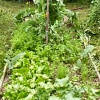 I thought it was probably time to update this page, which was written in 2002, and was really mainly for me to see whether I could write a web page.
I thought it was probably time to update this page, which was written in 2002, and was really mainly for me to see whether I could write a web page.
Since that time, a lot of water has gone under the bridge—or rather, a lot less water has fallen from the skies. Like the rest of the world, Victoria has experienced some unexpected and generally unpleasant reminders that global warming is happening fast. The permitted use of mains water on gardens is limited, and we've been working our way around this by catching rainwater and directing laundry, shower and bath water away from drains and into the garden.
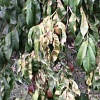 Few had prepared for the first heatwave, and plants carefully positioned so they'd get plenty of sunshine got far too much and were burnt and shrivelled, many beyond recovery.
Few had prepared for the first heatwave, and plants carefully positioned so they'd get plenty of sunshine got far too much and were burnt and shrivelled, many beyond recovery.
We began throwing old bed sheets over vulnerable plants, but pretty fierce winds were part of the problem, so the sheets were blown off and needed to be replaced half a dozen times each day. Not fun when you want to stay out of the sun yourself!
Shadecloth sounded like a good idea. Not only could it shield plants from the worst of the sun, but placed vertically along the north side of the vegie patch it blocked the drying winds. That worked well for the remainder of the first very hot year.
Unfortunately, I made no provision for easily rolling the shade cloth away when it wasn't needed, so during last year's considerably kinder summer plants were shaded every day and so were deprived of sufficient sunshine. To make matters worse, I'd been away from home during the time when one does early preparation—digging in manure and so on—so we had to fall back on packet fertilisers alone. Few things thrived.
A new season lies ahead, and maybe this summer I'll get it right; maybe. Some sort of frame to support the shadecloth, drawstrings to help with folding it back, and lots of early manuring. Perhaps the garden will flourish again! top
Asparagus
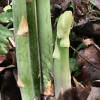 Asparagus is happy with
basil, marjoram, parsley and tomatoes. It is only worth growing if you plan to stay put; it takes years for asparagus to become properly established.
Asparagus is happy with
basil, marjoram, parsley and tomatoes. It is only worth growing if you plan to stay put; it takes years for asparagus to become properly established.
You need to have plenty of manure dug deeply into the bed, and the soil should be full of compost, leaf mould or some other sort of humus; asparagus doesn't do well in clay.
You plant asparagus "crowns" in midwinter. They don't look up to much. Scoop out a furrow a bit deeper than the length of your hand and make the sides a bit deeper, so that there's a sort of hill or ridge running along the middle. Sit each crown on top of this ridge, with the roots dangling down on both sides. Fill soil back into the trench and press it down really hard over the roots. You don't need to fill the furrow right up; you can lightly cover the shoot or leave it just above the surface. As the plants grow, you can fill more soil around them.
The next bit is the hardest: leave your asparagus alone for at least a year; don't cut it! After one year, or two if you can bear to wait, push a sharp knife into the soil beside a spear and try to cut it off well underground. top
Beans
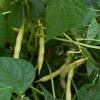 Beans of all kinds thrive in the company of any member of the cabbage family, as well as marjoram, rosemary and sage, but they don't do well close to onions or garlic. Climbing beans are much easier to look after than dwarf beans, although the latter probably include the ones that are nicest to eat, notably butter beans.
Beans of all kinds thrive in the company of any member of the cabbage family, as well as marjoram, rosemary and sage, but they don't do well close to onions or garlic. Climbing beans are much easier to look after than dwarf beans, although the latter probably include the ones that are nicest to eat, notably butter beans.
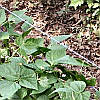 Try to support dwarf beans off the ground or they're likely to be nibbled by insects. One easy way is to hammer in a longish peg at each end of the row and run a piece of baling twine between the two pegs. Do the same thing on the other side of the row, then gently lift the bean plants up and over the twine so that they rest on it. As they get taller and begin to touch the ground again, make another run of twine above the first.
Try to support dwarf beans off the ground or they're likely to be nibbled by insects. One easy way is to hammer in a longish peg at each end of the row and run a piece of baling twine between the two pegs. Do the same thing on the other side of the row, then gently lift the bean plants up and over the twine so that they rest on it. As they get taller and begin to touch the ground again, make another run of twine above the first.
Old fashioned perennial climbing beans, like scarlet runner, look quite spectacular growing on a trellis or arch, but the beans themselves can be tough and stringy unless you pick them when they're very young. top
Broad Beans
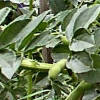 Broad beans are great! They grow during the cold months when there's not much else to make the garden look alive, and they're very good for the soil. Planting months in the Melbourne area are April and August; both crops seem to come in at about the same time, as do any self-sows.
Broad beans are great! They grow during the cold months when there's not much else to make the garden look alive, and they're very good for the soil. Planting months in the Melbourne area are April and August; both crops seem to come in at about the same time, as do any self-sows.
Empty beds can be sown with broad beans even if you think there'll be too many to use; dig the plants in as a green manure crop. This too is good for your garden soil.
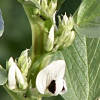 I've been told that the growing tips of broad bean plants, just as flowering begins, are an unusual but delicious green vegetable. Might be worth a try.
I've been told that the growing tips of broad bean plants, just as flowering begins, are an unusual but delicious green vegetable. Might be worth a try.
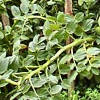
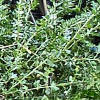 One thing that broad beans really do need is lots of support. Plenty of stakes, plenty of strings, else a decent sort of wind or a heavy downpour can leave them leaning in every position but up. This doesn't seem to do the plants much harm, but manoevering your feet between all those stems—which are probably wet with rain—to pick the beans can be tricky.
One thing that broad beans really do need is lots of support. Plenty of stakes, plenty of strings, else a decent sort of wind or a heavy downpour can leave them leaning in every position but up. This doesn't seem to do the plants much harm, but manoevering your feet between all those stems—which are probably wet with rain—to pick the beans can be tricky.
I sow broad beans closer together than recommended, and I think that helps them to support each other. However, I do always have heaps of last year's seed with which to be lavish; maybe if I had to buy seed my spacing would be a bit wider.
Liming is recommended, but I bury drayloads of oak leaves, which are known to be acidic, and the broad beans grow and bear well in spite of my never liming. When in doubt, ask your neighbours. top
Cabbages
Cabbages and their close relatives—cauliflowers, broccoli and brussels sprouts—like to be grown near other green leafy vegetables, any kind of beans or peas, as well as tomatoes, cucumbers and onions. They also grow well close to nasturtiums, which is interesting, as nasturtiums are a favourite of the cabbage white butterfly. Cabbages need to be planted in very well manured and composted soil. Broccoli is probably the most easily grown member of the family. If you keep picking the heads as soon as they're ready, more will develop. When buying cabbage plants, choose small varieties. They take up much less space and are generally more useful.
Except for broccoli, I've given up on the cabbage family. Just too much trouble for too little return. However, it occurs to me that if one really did love cabbage, you could probably solve the caterpillar problem with mosquito net. After all, pollination isn't needed, so why not block away insects altogether? top
Capsicums and Peppers
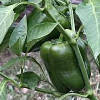
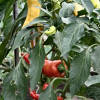 Capsicums are a lovely summer vegetable cooked or raw—they can even be eaten in the hand, like an apple. My grandson does a mean stuffed capsicum, involving feta cheese, olives, sun-dried tomatoes and lashings of olive oil. I'm sure they can't be healthy—they taste far too good!
Capsicums are a lovely summer vegetable cooked or raw—they can even be eaten in the hand, like an apple. My grandson does a mean stuffed capsicum, involving feta cheese, olives, sun-dried tomatoes and lashings of olive oil. I'm sure they can't be healthy—they taste far too good!
Capsicums are related to tomatoes and are grown the same way. The rule used to be never to plant them out before late September, to avoid the risk of loss from frost. Since we haven't had a lot of frost in the last few years, we've been setting out a plant or two rather earlier, just to see how they go. If you raise them from seed yourself, it's not a huge risk.
As with tomatoes, capsicums like you to have dug in heaps of manure a month or so before planting. You can also put a spoonful of special tomato fertiliser well below each plant if you want to. Once the plants are well established, an occasional watering with a soluble potash-rich booster encourages flowering and fruiting.
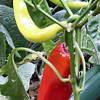
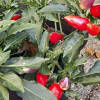 We have grown some long sweet capsicums successfully in a very large flower pot. The advantage was that it was easier to get the plant into shade when the weather was really terrible.
We have grown some long sweet capsicums successfully in a very large flower pot. The advantage was that it was easier to get the plant into shade when the weather was really terrible.
The little brutes on the right we bought in a pot. Strictly ornamental. The label said "edible", but it must've been written by someone with a cast-iron tongue. Hot! Very, very hot! top
.
Carrots
 Carrots will grow happily in the same area as almost any vegetable other than parsnips. The most important things to remember when growing carrots are that the soil must be deep and crumbly and that some other crop—broad beans, perhaps—should have been grown since the last time manure was applied. Neglecting either of these criteria may cause the carrots to have branching roots.
Carrots will grow happily in the same area as almost any vegetable other than parsnips. The most important things to remember when growing carrots are that the soil must be deep and crumbly and that some other crop—broad beans, perhaps—should have been grown since the last time manure was applied. Neglecting either of these criteria may cause the carrots to have branching roots.
Carrots are always handy and it's a good idea to sow another lot when the first is ready for use. If you watch the varieties you can grow carrots most of the year. Little people love to pull up a carrot to eat raw—just make sure they know to bring it inside and wash it properly first!
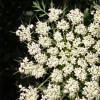
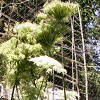 If you let carrots go to seed you'll find they have remarkable flowers. They can be a couple of metres off the ground and are very showy. I've seen jerusalem artichoke flowers in florists' shops, labelled "sunflowers", but never carrot flowers. A shame. top
If you let carrots go to seed you'll find they have remarkable flowers. They can be a couple of metres off the ground and are very showy. I've seen jerusalem artichoke flowers in florists' shops, labelled "sunflowers", but never carrot flowers. A shame. top
Corn or Maize
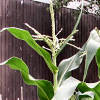
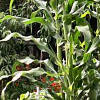 Sweet corn will grow well in most company, provided that the ground is well manured and gets full sunshine throughout the day. It's a particularly good plant for small children to watch growing, as all the stages of development are very obvious and they can eat it straight from the plant without any worries about dirt. They do need to know how to pick it without breaking the whole plant, though, and if they're very small it's probably better for an adult to pick it for them. Corn also has the advantage of loosening the soil for subsequent root crops, such as carrots or parsnips. It does take a lot of space, though, and takes about four months to produce. It must be staked to protect it from the wind, and it can overshadow more useful crops, depriving them of sunshine.
Sweet corn will grow well in most company, provided that the ground is well manured and gets full sunshine throughout the day. It's a particularly good plant for small children to watch growing, as all the stages of development are very obvious and they can eat it straight from the plant without any worries about dirt. They do need to know how to pick it without breaking the whole plant, though, and if they're very small it's probably better for an adult to pick it for them. Corn also has the advantage of loosening the soil for subsequent root crops, such as carrots or parsnips. It does take a lot of space, though, and takes about four months to produce. It must be staked to protect it from the wind, and it can overshadow more useful crops, depriving them of sunshine.
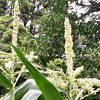
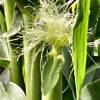 If the bee population has dropped off in your area and there hasn't been much wind you may be concerned because plants are not setting fruit. Well, corn is one plant that you can easily pollinate yourself.
If the bee population has dropped off in your area and there hasn't been much wind you may be concerned because plants are not setting fruit. Well, corn is one plant that you can easily pollinate yourself.
Pollen is on the parts at the very top of the plant. The cobs-to-be are in the axils of the leaves, where they join the main stem. You may or may not notice a few strands of green "silk" in that position. (Not nearly as much as in the right-hand picture though; that cob is definitely already developing.)Having picked off a pollen-bearing piece from the top of the plant, dust it into each axil in turn. I can't swear blind that it worked for me; maybe pollination had happened already, but I really did have more cobs per plant when I did it.
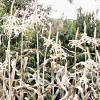 This is what the heatwave did to a stand of our corn. Some cobs were nicely developed and more were coming along and were at the "baby corn" stage.
This is what the heatwave did to a stand of our corn. Some cobs were nicely developed and more were coming along and were at the "baby corn" stage.
All killed dead in just one day! top
.
Cucumbers
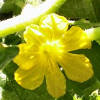 Cucumbers need a sunny area that is open to the wind. They like plenty of manure, and a good way to arrange this is to dig a hole big enough to accommodate about half a bucketful, fill it, cover it with earth, press it all well down and then build a hill on top, using about twice the quantity of earth that you dug out in the first place. Put two or three seeds or plants on the summit of the hill. The rotting manure
will warm the soil and the young plants above it, and will be less potent and likely to burn the roots when they eventually grow down to it. Being slightly elevated, the plants will be less subject to dampness, which can cause the leaves to develop a growth of mildew. Water will run to the bottom of the hill, soak into the ground and be available to the roots, leaving the leaves high and dry.
Cucumbers need a sunny area that is open to the wind. They like plenty of manure, and a good way to arrange this is to dig a hole big enough to accommodate about half a bucketful, fill it, cover it with earth, press it all well down and then build a hill on top, using about twice the quantity of earth that you dug out in the first place. Put two or three seeds or plants on the summit of the hill. The rotting manure
will warm the soil and the young plants above it, and will be less potent and likely to burn the roots when they eventually grow down to it. Being slightly elevated, the plants will be less subject to dampness, which can cause the leaves to develop a growth of mildew. Water will run to the bottom of the hill, soak into the ground and be available to the roots, leaving the leaves high and dry.
Cucumbers go where they will. Find one straggling across a path and lift it ever so gently back onto the bed and in a day or two it'll be back in the place of its choice.
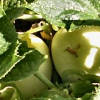
 I like apple cucumbers best. They bear prolifically and don't seem quite as bothered by extreme temperatures as the ordinary ones. That's not to say they'll withstand really bad heat; they just seem to cope a little better.
I like apple cucumbers best. They bear prolifically and don't seem quite as bothered by extreme temperatures as the ordinary ones. That's not to say they'll withstand really bad heat; they just seem to cope a little better.
Lebanese cucumbers are very popular; they have a softer skin than either apple cucumbers or the ordinary kind. They seem to be a little bit harder to grow, but once they're established they're worth the effort.
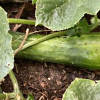 This cucumber had a bad time with the hot weather, not fattening up as it should, although it was still edible. Many others cooked in their skins, turning to a soupy mush, while a few that were partly protected by foliage just ripened, the skin turning yellow and the inside softening unpleasantly. top
This cucumber had a bad time with the hot weather, not fattening up as it should, although it was still edible. Many others cooked in their skins, turning to a soupy mush, while a few that were partly protected by foliage just ripened, the skin turning yellow and the inside softening unpleasantly. top
.
Egg Plant or Aubergine
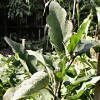
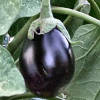 Eggplants have similar requirements to those of tomatoes and capsicums: well enriched soil and lots of sunshine. With regard to low temperatures and avoidance of frost, though, they're even more sensitive, and should probably not be planted until as much as a month after the earliest tomatoes.
Eggplants have similar requirements to those of tomatoes and capsicums: well enriched soil and lots of sunshine. With regard to low temperatures and avoidance of frost, though, they're even more sensitive, and should probably not be planted until as much as a month after the earliest tomatoes.
They seem to cope with very high temperatures a little better than tomatoes, although there are limits.
Both the plant and the fruit are very easy on the eye. It's a nice upright plant with large greyish green leaves, while the deep purple fruit is smooth and has a lovely sheen. Where the eggplant falls down, though, is in the eating. The flesh has a spongy texture and, apart from a faint bitterness, practically no taste at all. Many recipes for cooking it involve flavourful ingredients such as salt, olive oil, strong cheese, tomato and garlic—the eggplant part of the recipes probably supplies nothing but bulk. Recipes often begin with "sweating" sliced eggplant to remove bitterness. This simply means covering the slices with salt, leaving them to stand for several hours and then rinsing in clean cold water.
One old recipe for frying slices of eggplant and serving them with bacon stated that it tasted "not unlike fried egg". Gosh. The writer must've fed his chooks on bread and water! top
.
Lettuces
Lettuces grow happily near beans, the cabbage family, cucumbers, carrots and strawberries. That said, it's best to put them where there's nothing that prefers overhead watering. Sprinkling can ruin lettuces, turning their hearts into a disgusting slimy mess. Try to form a small gutter beside a row of lettuces, or around individual plants, so that water can be applied at ground level and will run to the roots without over-wetting the leaves. Lots of manure or compost dug in a few weeks before planting will ensure their growth. Snails are very fond of young lettuce plants, so make some provision to protect them.
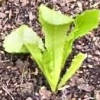 Lettuces grown from bought seedlings are usually all ready at the same time, which may not be what you want. Some people retard part of the box of seedlings by transplanting twice. Growing from seed may be more convenient, but do pay attention to advice on the seed packet about when to sow.
Lettuces grown from bought seedlings are usually all ready at the same time, which may not be what you want. Some people retard part of the box of seedlings by transplanting twice. Growing from seed may be more convenient, but do pay attention to advice on the seed packet about when to sow.
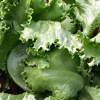 Some varieties tend to bolt if sown at the wrong time of year. Lettuce are related to dandelions and it can be hard to tell the very young seedlings apart. For this reason it's wise to make sure, if you're growing from seed, that you mark the row with some care so that you don't pull up the baby lettuces by mistake.
Some varieties tend to bolt if sown at the wrong time of year. Lettuce are related to dandelions and it can be hard to tell the very young seedlings apart. For this reason it's wise to make sure, if you're growing from seed, that you mark the row with some care so that you don't pull up the baby lettuces by mistake.
While I prefer the standard iceberg style, many varieties of non-hearting lettuce can be bought as seedlings, often with half a dozen varieties in the one lot. They may have coloured leaves, very frilly leaves, or be otherwise visually attractive and therefore rather nice to brighten the appearance of summer salads. My experience has been that some of these tend to get away and go to seed while your back's turned, so keep an eye on them or you may have young lettuves coming up all over the garden. top
.
Parsnips
Parsnips may not be worth the trouble. They have similar requirements to carrots, but both crops suffer if they are grown close together, and carrots are far more versatile. There are few uses for young parsnips pulled out to thin the crop, and if they are crowded they tend to be uniformly poor. As well as that, although parsnip seed is viable for a very short time—seed more than twelve months old doesn't always germinate—a single parsnip plant allowed to go to seed will have generations of offspring springing up all over the garden. If you're fond enough of this vegetable, make sure that the soil is deep and crumbly, and remember not to use manure or compost. top
Peas
 Peas like to grow near beans, cabbages, and any salad vegetables except for the onion family. The climbing kind are much easier to look after, and come in both the ordinary varieties and the sugar snap or snow pea types. Put them near a fence or trellis, or erect something for them to climb on.
Peas like to grow near beans, cabbages, and any salad vegetables except for the onion family. The climbing kind are much easier to look after, and come in both the ordinary varieties and the sugar snap or snow pea types. Put them near a fence or trellis, or erect something for them to climb on.
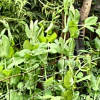 A tepee arrangement of bamboo or thin stakes makes a good foundation, and you can strengthen it with ordinary baling twine. When the time for sowing peas begins, put in a row or circle every couple of weeks. Sowing more seeds between existing plants seems to work well.
A tepee arrangement of bamboo or thin stakes makes a good foundation, and you can strengthen it with ordinary baling twine. When the time for sowing peas begins, put in a row or circle every couple of weeks. Sowing more seeds between existing plants seems to work well.
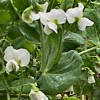 The younger plants can use the bigger ones for support. Gardening books recommend that the ground for peas needs to be limed. This varies from place to place, so ask someone in your area whether they find liming necessary.
The younger plants can use the bigger ones for support. Gardening books recommend that the ground for peas needs to be limed. This varies from place to place, so ask someone in your area whether they find liming necessary.
Snails are very efficient at finding newly emerged pea plants. If you think that your peas haven't sprouted, maybe they came up one evening and were all eaten by morning. top
Radishes
Radishes grow quickly and easily, so are a nice thing for little children to try. The ground needs to be reasonably crumbly, although not as deep as for carrots. A very small patch is easier to look after than a long row. Keep the water up to them so that they grow quickly and aren't too hot. Some people sow radish and carrot seed together. The radishes develop first, are pulled and eaten, and make way for the growth of the carrots. top
Rhubarb
Rhubarb is very easy to grow and a great standby for adding colour and extra tartness to stewed fruit or fruit pies. A small stick can be eaten in the hand by those fond of acid tastes, but stewed alone it really needs a lot of sugar to make it palatable. Once planted, rhubarb can be left in the same bed for years, requiring only that manure be dug in nearby each year, and that the bed be well drained and in a sunny position.
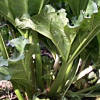 This particular rhubarb was disappointing because it lacked colour. The flavour was the same as that of regular rhubarb, the plant grew vigorously and made new crowns, but the cooked appearance was disappointing.
This particular rhubarb was disappointing because it lacked colour. The flavour was the same as that of regular rhubarb, the plant grew vigorously and made new crowns, but the cooked appearance was disappointing.
Rhubarb leaves are very poisonous, so do take care with small children and animals. I once had a horrible experience with some escaped guinea pigs. top
.
Silver Beet
Silver beet is one of the most rewarding things you can grow at home. It grows quickly in ordinary well composted soil and you can go on picking just as much as you need for months on end. It's one plant that's happy to grow near onions, too, as well as any other garden plants. If you don't have a garden, grow one silver beet plant in the biggest pot you can find. Plastic pots are better for this than terra cotta, even though they don't look as nice. Terra cotta allows too much evaporation from the sides. If you need to leave the pot unattended for a couple of days, fill large plastic lemonade bottles with water and poke their necks into the potting mix near the edge of the pot. Potting mix is preferable to garden soil, because garden soil just doesn't drain as well. top
Strawberries
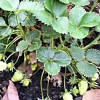 Strawberries will last for years if you prepare well. Before you get your plants, dig a trench along the middle of a narrow bed. Fill it with manure and compost, and cover the earth back over, so that the middle of the bed is slightly raised. After a few weeks, remove the newly grown weeds and space your strawberry plants along the middle of the bed. Within a few months young plants will appear on runners that come out from each plant. You cut off the runners, take the biggest new plants and plant them towards the sides of the bed or between the original plants.
Strawberries will last for years if you prepare well. Before you get your plants, dig a trench along the middle of a narrow bed. Fill it with manure and compost, and cover the earth back over, so that the middle of the bed is slightly raised. After a few weeks, remove the newly grown weeds and space your strawberry plants along the middle of the bed. Within a few months young plants will appear on runners that come out from each plant. You cut off the runners, take the biggest new plants and plant them towards the sides of the bed or between the original plants.
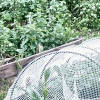 Strawberries are much loved by blackbirds, but there is a fairly cheap and simple way to protect them. Buy a roll of the black plastic tubing that is used for garden spray or drip systems. Cut it into pieces about twice the width of the bed and use the pieces to form arches over the bed. If the bed has board or brick sides, tuck the ends down inside them. Otherwise, drive in short narrow stakes and push the ends of the tubing onto them. When the fruit begins to colour, get nylon bird netting from your hardware shop or nursery and drape it over the tubing arches. Let the sides and ends rest on the path so that people can easily lift the netting to pick the fruit.
Strawberries are much loved by blackbirds, but there is a fairly cheap and simple way to protect them. Buy a roll of the black plastic tubing that is used for garden spray or drip systems. Cut it into pieces about twice the width of the bed and use the pieces to form arches over the bed. If the bed has board or brick sides, tuck the ends down inside them. Otherwise, drive in short narrow stakes and push the ends of the tubing onto them. When the fruit begins to colour, get nylon bird netting from your hardware shop or nursery and drape it over the tubing arches. Let the sides and ends rest on the path so that people can easily lift the netting to pick the fruit.
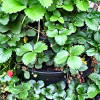 We made a stawberry tower, mainly to avoid throwing away lots of newly formed strawberry plants, but also because we could then have strawberries right otside the door. We used four black plastic pots in graduated sizes. We filled each pot about a third of the way up with sheep manure, then sat the next size on the manure. When they were all stacked up, we filled to the top of each pot with a bit more manure and some good composty soil.
We made a stawberry tower, mainly to avoid throwing away lots of newly formed strawberry plants, but also because we could then have strawberries right otside the door. We used four black plastic pots in graduated sizes. We filled each pot about a third of the way up with sheep manure, then sat the next size on the manure. When they were all stacked up, we filled to the top of each pot with a bit more manure and some good composty soil.
With a bucket of water close by, we planted as many young strawberries as seemed reasonable right around the exposed surface of each pot, firming down the roots as well as was possible and flooding water onto each one as we went. The plants took off in no time, but those at the top were soon ahead of the lower ones and they began to bloom in short order. Few of the lowest ones bloomed, and none of them set fruit, while the top and second-to-top plants had enough to make the exercise worthwhile.
The whole heavy tower needed to be turned every three or four days so that a different side faced the morning sun, and we had to throw bird netting over the whole arrangement, since the blackbirds gave it their almost undivided attention. Probably, with a little more care this system would be very good where space is limited. Here, though, the yield-for-labour return is much better in conventional beds. top
.
Tomatoes
 Tomatoes are the favourite home grown vegetable. In the open garden you can dig in lots of manure and compost before you start planting, and there are also packeted fertilisers especially for use at tomato planting time. If you use these, though, read the directions attentively and avoid being generous. Some of these fertilisers are very strong, and overdosing can severely damage or even kill the young tomato plants. Too little is much better than too much. If you decide to grow tomatoes in pots or tubs, it's probably easier to use just compost and packeted fertiliser.
Tomatoes are the favourite home grown vegetable. In the open garden you can dig in lots of manure and compost before you start planting, and there are also packeted fertilisers especially for use at tomato planting time. If you use these, though, read the directions attentively and avoid being generous. Some of these fertilisers are very strong, and overdosing can severely damage or even kill the young tomato plants. Too little is much better than too much. If you decide to grow tomatoes in pots or tubs, it's probably easier to use just compost and packeted fertiliser.
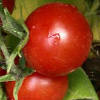
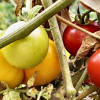 Grow a few good plants rather than lots of cheaper ones. There is work involved, and you don't want to spend your entire summer looking after dozens of tomato plants. Every plant needs to be staked, no matter what it says on the label when you buy it. Be ready to stake early, before the plants decide to hug the ground or drape themselves across paths. If you try to lift them once that happens, you'll find that they're quite brittle and breaking them is almost unavoidable.
Grow a few good plants rather than lots of cheaper ones. There is work involved, and you don't want to spend your entire summer looking after dozens of tomato plants. Every plant needs to be staked, no matter what it says on the label when you buy it. Be ready to stake early, before the plants decide to hug the ground or drape themselves across paths. If you try to lift them once that happens, you'll find that they're quite brittle and breaking them is almost unavoidable.
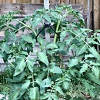 Some wise old gardeners put full sized stakes in when they first plant, even though the plants are tiny. This avoids having to drive a stake through healthy roots when the plant is established. If you think that tall stakes beside tiny plants look incongruous, put in short ones, driving them very deep. You can pull these out and replace them a little later.
Some wise old gardeners put full sized stakes in when they first plant, even though the plants are tiny. This avoids having to drive a stake through healthy roots when the plant is established. If you think that tall stakes beside tiny plants look incongruous, put in short ones, driving them very deep. You can pull these out and replace them a little later.
.

 When the weather became suddenly hotter than normal, our tomato plants quickly showed the effects. On the first day, many leaves were completely burnt. It was a terribly hot day though. The thermometer on the right was on a curtained patio under a large leafy pin oak tree.
When the weather became suddenly hotter than normal, our tomato plants quickly showed the effects. On the first day, many leaves were completely burnt. It was a terribly hot day though. The thermometer on the right was on a curtained patio under a large leafy pin oak tree.
On subsequent days we threw bed sheets over the plants, but with limited success. In places the sheets were blown off and many of the exposed fruit were cooked inside their skins.
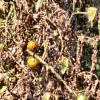 A few plants growing against an east-facing wall were fully shaded during the worst part of the day and survived, but most that had been planted in the open garden were reduced to a tangle of dead vines.
A few plants growing against an east-facing wall were fully shaded during the worst part of the day and survived, but most that had been planted in the open garden were reduced to a tangle of dead vines.
Ah well, this year, with shadecloth when necessary—but only when necessary—I'm sure we'll get back to having a decent crop of healthy, full-flavoured tomatoes. top
.
Zucchini or Courgettes
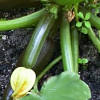 Zucchini are a very encouraging thing to grow. They seem to be incapable of failing to thrive and are no trouble at all, except insofar as they'll attempt to cover the whole garden if not kept in check. My dad called them marrows, and grew them to be as long as his forearm, at which stage they were usually stuffed with seasoned minced meat and baked in the oven. Now it's more usual to pick them very young and either cook them in any of a dozen different ways or slice them into a salad. The flowers can be eaten too, although the stamens or pistil should be removed first.
Zucchini are a very encouraging thing to grow. They seem to be incapable of failing to thrive and are no trouble at all, except insofar as they'll attempt to cover the whole garden if not kept in check. My dad called them marrows, and grew them to be as long as his forearm, at which stage they were usually stuffed with seasoned minced meat and baked in the oven. Now it's more usual to pick them very young and either cook them in any of a dozen different ways or slice them into a salad. The flowers can be eaten too, although the stamens or pistil should be removed first.
Zucchini should be grown in an exposed position so that they get enough wind to deter mildew. Dig a hole a bit deeper than big enough to take a bucketful of manure. Put the manure in, put the soil back, firm it all down, then draw soil from the sides of the bed to form a small hill. Put two or three plants in the top of the hill, or push in half a dozen seeds and again firm the soil. Water as necessary and await developements.
Once the plants are well established, remove all but the two best ones. (Yes, that's hard, I know. Give them to a neighbour.) Once fruiting begins, try to keep up with picking; these plants are truly prolific! top
.
Questions or comments? I’d love to hear from you. My email address is here.
Return to top
Drop-Down Menu from Brothercake
Everything below this is a javascript menu. If you are using a reader,
please use the links here.